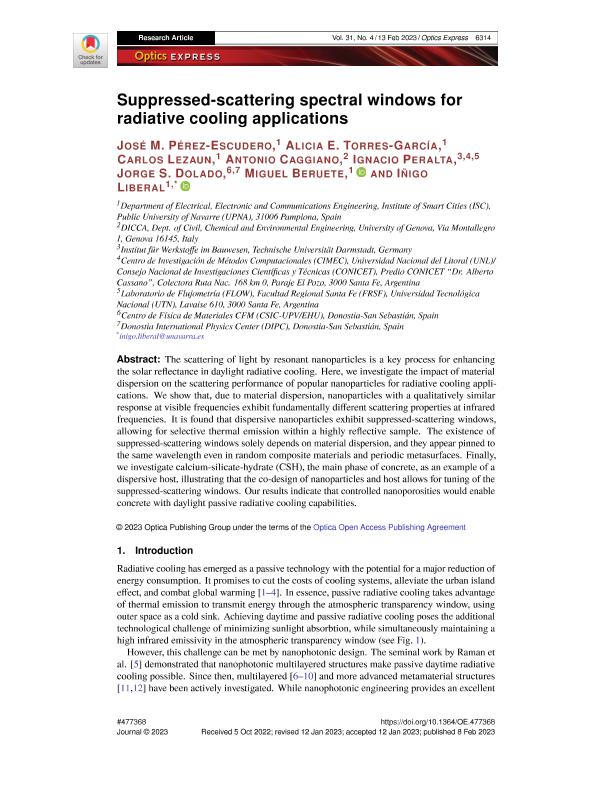Mostrar el registro sencillo del ítem
dc.contributor.author
Pérez Escudero, José M.
dc.contributor.author
Torres García, Alicia E.
dc.contributor.author
Lezaun, Carlos
dc.contributor.author
Caggiano, Antonio
dc.contributor.author
Peralta, Ignacio

dc.contributor.author
Dolado, Jorge S.
dc.contributor.author
Beruete, Miguel
dc.contributor.author
Liberal, Iñigo
dc.date.available
2024-02-05T14:58:46Z
dc.date.issued
2023-02
dc.identifier.citation
Pérez Escudero, José M.; Torres García, Alicia E.; Lezaun, Carlos; Caggiano, Antonio; Peralta, Ignacio; et al.; Suppressed-scattering spectral windows for radiative cooling applications; Optical Society of America; Optics Express; 31; 4; 2-2023; 6314-6326
dc.identifier.issn
1094-4087
dc.identifier.uri
http://hdl.handle.net/11336/225828
dc.description.abstract
The scattering of light by resonant nanoparticles is a key process for enhancing the solar reflectance in daylight radiative cooling. Here, we investigate the impact of material dispersion on the scattering performance of popular nanoparticles for radiative cooling applications. We show that, due to material dispersion, nanoparticles with a qualitatively similar response at visible frequencies exhibit fundamentally different scattering properties at infrared frequencies. It is found that dispersive nanoparticles exhibit suppressed-scattering windows, allowing for selective thermal emission within a highly reflective sample. The existence of suppressed-scattering windows solely depends on material dispersion, and they appear pinned to the same wavelength even in random composite materials and periodic metasurfaces. Finally, we investigate calcium-silicate-hydrate (CSH), the main phase of concrete, as an example of a dispersive host, illustrating that the co-design of nanoparticles and host allows for tuning of the suppressed-scattering windows. Our results indicate that controlled nanoporosities would enable concrete with daylight passive radiative cooling capabilities.
dc.format
application/pdf
dc.language.iso
eng
dc.publisher
Optical Society of America

dc.rights
info:eu-repo/semantics/openAccess
dc.rights.uri
https://creativecommons.org/licenses/by-nc-sa/2.5/ar/
dc.subject
Radiative cooling
dc.subject
Nanoparticles
dc.subject
Concrete
dc.subject.classification
Otras Ciencias Físicas

dc.subject.classification
Ciencias Físicas

dc.subject.classification
CIENCIAS NATURALES Y EXACTAS

dc.title
Suppressed-scattering spectral windows for radiative cooling applications
dc.type
info:eu-repo/semantics/article
dc.type
info:ar-repo/semantics/artículo
dc.type
info:eu-repo/semantics/publishedVersion
dc.date.updated
2024-02-05T13:39:57Z
dc.journal.volume
31
dc.journal.number
4
dc.journal.pagination
6314-6326
dc.journal.pais
Estados Unidos

dc.description.fil
Fil: Pérez Escudero, José M.. Universidad Pública de Navarra; España
dc.description.fil
Fil: Torres García, Alicia E.. Universidad Pública de Navarra; España
dc.description.fil
Fil: Lezaun, Carlos. Universidad Pública de Navarra; España
dc.description.fil
Fil: Caggiano, Antonio. Università degli Studi di Genova; Italia
dc.description.fil
Fil: Peralta, Ignacio. Universitat Technische Darmstadt; Alemania. Universidad Nacional del Litoral; Argentina. Universidad Tecnológica Nacional; Argentina. Consejo Nacional de Investigaciones Científicas y Técnicas; Argentina
dc.description.fil
Fil: Dolado, Jorge S.. Consejo Superior de Investigaciones Científicas; España. Universidad del País Vasco; España
dc.description.fil
Fil: Beruete, Miguel. Universidad Pública de Navarra; España
dc.description.fil
Fil: Liberal, Iñigo. Universidad Pública de Navarra; España
dc.journal.title
Optics Express

dc.relation.alternativeid
info:eu-repo/semantics/altIdentifier/doi/https://doi.org/10.1364/OE.477368
dc.relation.alternativeid
info:eu-repo/semantics/altIdentifier/url/https://opg.optica.org/oe/fulltext.cfm?uri=oe-31-4-6314&id=525896
Archivos asociados
